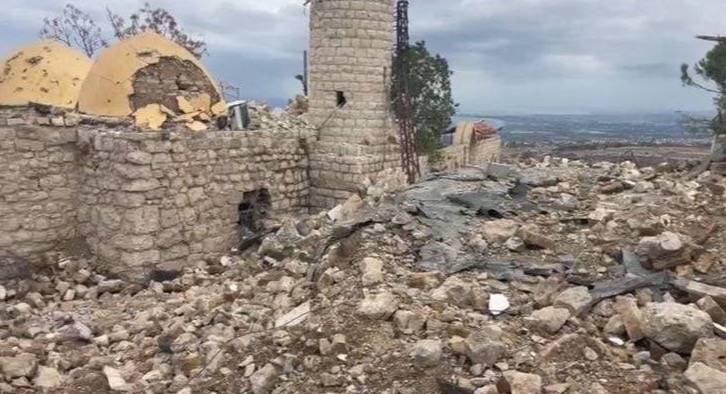The maqam of 'Simon Peter’ and sites placed at risk by the war between Israel and Hezbollah
Israeli attacks on the "party of God" have damaged a medieval castle and a Shia shrine in Shamaa, a village near Tyre. The site is dedicated to Shamoun al-Safa, who is none other than the first pontiff of Christianity, and still bears traces of a chapel. To be certain if ancient relics are inside, Israeli forces have to pull back.
Beirut (AsiaNews) – The whole of Lebanon trembled as Israeli strikes in the war between Israel and Hezbollah moved closer to some of the country’s most important archaeological sites, especially Baalbek, the ancient Heliopolis of Rome, as famous as the Parthenon and the Colosseum.
As a matter of urgency, Lebanon requested and obtained that UNESCO protection at 34 of its sites be doubled. However, the November ground fighting between Hezbollah and the Israeli army got the better of this protection, in the case of the medieval castle of Shamaa, near Tyre, and the shrine (maqam) of Shamoun Al Safa, which it houses.
The castle and shrine, located 25 km southeast of Tyre, were hit, but the extent of the damage is still unknown as the Israeli army has not yet withdrawn from the area.
The site is located on a splendid hill overlooking the sea. As is customary for maqams, Shias choose the most beautiful sites for places of prayer in the absence of mosques.
The maqam of Shamoun Al Safa, whose stones date back to the 1st century, has a unique historical value, because for Arab Christians, it is none other than Semaan el-Safa or Simon Peter. Indeed, in Arabic, Shamoun becomes Semaan (Simon or Simeon), and Safa is the Arabic contraction of the moniker Cephas[*] given by Jesus to his apostle.
If the maqam is so special, it is, first of all, because these shrines are dedicated, in general, either to scholars who led exemplary lives, or to people whose names appear in the Qur'an and the Old Testament such as Noah, Job or Joshua.
The maqam of Shamoun consists of a crypt, a kind of burial chamber in the basement, which is accessed through a circular opening covered with a wooden formwork. The whole is enclosed inside a rich arcaded room surmounted by four domes. The soil is the most sacred part of it.
According to Haidar Hawila, a resident of Shamaa who had the opportunity to approach it, the Israeli army seems to have taken samples inside the crypt, whose formwork was moved, "but with care," according to this witness.
The information is all the more credible since Hezbollah killed, in Shamoun, a 71-year-old Israeli archaeologist, Zeev Urlich, who entered with the Israeli army "without the necessary authorisations", in full military fatigues.
If the Israelis really examined the floor of the maqam, they did a job that the Lebanese neglected to do, this according to archaeologist Ali Badawi, regional director for South Lebanon in the General Directorate of antiquities, Ministry of Culture, “because of the Eastern custom of respecting the dead”.
That said, how can we explain the fact that a Shia funerary monument, a branch of Islam that emerges in the 8th century AD, is dedicated to Saint Peter the Apostle, who died as a martyr in Rome in the year AD 64?
The answer is provided by the oral tradition in Shamaa, according to which, for the Shia community, Shamoun el-Safa is an ancestor of Imam Al-Mahdi, whose mother was a Christian, before embracing Islam. "Occulted," this eschatological figure must reappear at the End of Time.
Is it possible that the maqam contains relics of the first bishop of Rome, and if so, which ones? Is this a fanciful idea? Is the maqam just an empty tomb? Not necessarily!
For Ali Badawi, the foundations of a chapel have been identified near the maqam, which proves that the place was already consecrated before the advent of Islam (AD 632). Thus, going back to Christian antiquity, the maqam of Shamoun could have some surprises in store for researchers. If it's not too late...
In the meantime, what we can say is that the whole of Lebanon is a precious reliquary of sites like this one. If better recorded, data from places like the Maqam of Shamoun al-Safa in Shamaa could teach Lebanon’s new generations a lesson or two about open-mindedness, which is not necessarily relativism, but a form of lucidity to the diversity of their roots and their greater or lesser importance in popular culture and ways of thinking.
[*] From the Aramaic Kepha, stone or rock.
14/10/2021 17:14
10/03/2020 18:25









.png)










